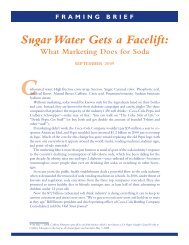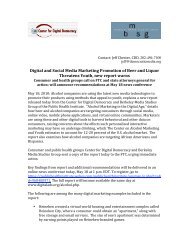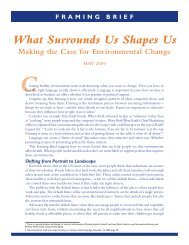"Interactive Food & Beverage Marketing" (PDF)
"Interactive Food & Beverage Marketing" (PDF)
"Interactive Food & Beverage Marketing" (PDF)
Create successful ePaper yourself
Turn your PDF publications into a flip-book with our unique Google optimized e-Paper software.
<strong>Interactive</strong> <strong>Food</strong> & <strong>Beverage</strong> Marketing | The New Digital Marketing Landscape<br />
• At General Mills’ Millsberry.com website, children are encouraged to make the<br />
“best movie” about “Lucky” (of Lucky Charms) and then vote for the winning<br />
video. The site provides a pre-branded kit of settings and spokescharacters,<br />
making it easy to combine them into a personalized commercial. 196<br />
• Pizza Hut launched a recent contest inviting pizza enthusiasts to create a short<br />
video “demonstrating their devotion to Pizza Hut Pizza” and showing why they<br />
should earn the title of “Honorary Vice President of Pizza.” Contestants were<br />
encouraged to engage in a variety of creative acts to show their loyalty to the<br />
brand, such as “decorating their room with Pizza Hut memorabilia.” Entrants<br />
submitted their videos on YouTube, ensuring they would be seen by thousands<br />
of viewers, whether they won or not. 197<br />
• With a code from a 20-oz bottle of Sprite, visitors to the Lebron 2323 site were<br />
invited to “help create a theme song for LeBron James.” The site offered online<br />
audio and video mixing tools to enable young people to remix the audio track to<br />
a Sprite Sublymonal television spot featuring the NBA star. Add a viral element<br />
(“Promote your track on your social networking profile to get votes—the top vote<br />
getters get judged by LeBron James and our celebrity artists—Paul Wall & Al<br />
Fatz...”) and the promise of broad exposure (“The top 3 tracks get premiered in<br />
the new Sprite/LeBron TV spot during NBA All-Star 2007”), and Coca-Cola’s<br />
Sprite division enjoyed the support of thousands of volunteer online marketers.<br />
198<br />
While some industry observers have expressed concern over consumers gaining<br />
too much control and creating videos that may undermine, rather than enhance, a<br />
brand’s image, most marketers have figured out how to make the boom in user-generated<br />
content work for them. For example, the Coca-Cola Company initially played down the phenomenal<br />
success of the unauthorized viral video—viewed by millions on YouTube—in<br />
which Mentos candy is dropped into a Diet Coke, triggering a chemical explosion. Officials<br />
told The Wall Street Journal that while the video was “entertaining,” it didn’t “fit with the<br />
brand personality.” However, the company subsequently decided to proactively build consumer-generated<br />
content into its Coke.com site, tempering unfettered online expression<br />
with a carefully calculated campaign. “We give the structure, we try to give the guidance,”<br />
one official told IQ <strong>Interactive</strong>, “but we’re looking for consumers to fill it with content<br />
that’s relevant to them rather than us talking to them.” 199 In August 2006, the website<br />
began featuring a series of monthly challenges that encourage people around the world<br />
to create videos in response to a theme. The first challenge on the site, “The Essence of<br />
You,” asks, “If you could bottle the essence of you and share it with the world, what story<br />
would you tell?” Visitors can vote on each other’s work, and the winner is awarded about<br />
$5,000 worth of video equipment and editing software. “We’re bringing a global creative<br />
community together,” explained a Coke spokesperson. “It’s not just the U.S. creative<br />
teenagers uploading their videos. It’s going to be everyone around the world, and you’re<br />
going to see everybody’s [stuff].” 200<br />
47









